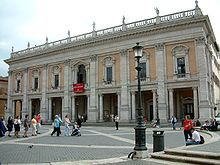Our website is made possible by displaying online advertisements to our visitors.
Please consider supporting us by disabling your ad blocker.
Giant order

In classical architecture, a giant order, also known as colossal order, is an order whose columns or pilasters span two (or more) storeys. At the same time, smaller orders may feature in arcades or window and door framings within the storeys that are embraced by the giant order.[1]
The giant order was rare in antiquity. Vitruvius' depiction of the lost Basilica of Fanum contains columns spanning two stories.[2] Roman architectural historian Mark Wilson Jones also cites the columns at the Basilica of Pompeii, the Baths of Diocletian, and the Temple of Baachus at Baalbek as early examples of the giant order.[3] To an extent buildings with giant orders resemble a Roman temple adapted for post-classical use,[4] as many were (the survivors have now usually been stripped of later filling-in).
- ^ Summerson 1980, pp. 63, 72.
- ^ "VITRUVIUS' BASILICA AT FANO – Russell Taylor Architects". 2023-04-25. Retrieved 2024-09-11.
- ^ Wilson Jones, Mark (2003). Principles of Roman architecture (2. printing with corr ed.). New Haven, Conn.: Yale Univ. Press. p. 117. ISBN 978-0-300-10202-4.
- ^ Summerson 1980, p. 63.
Previous Page Next Page


